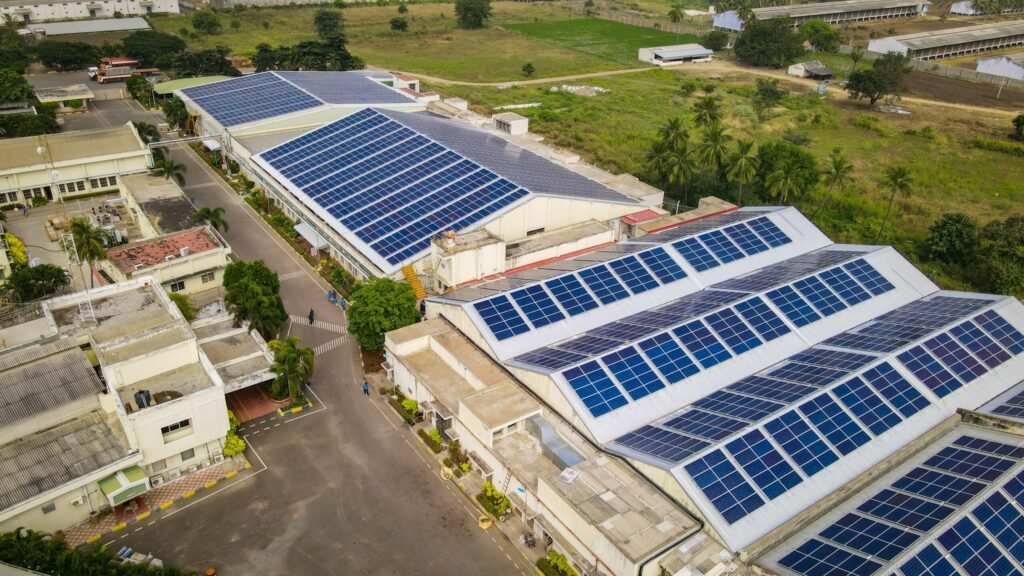Many commercial buildings in Indian cities have very little free roof area. Yet, they still need reliable, affordable power. Commercial rooftop solar can help — if designed smartly. This guide shows practical ways to install solar power systems on tight sites. It covers panel selection, rooftop layout ideas, alternative mounting options, battery storage, financing models, and policy support in India.
Why solar power matters even with little space

Solar energy reduces electricity bills, cuts diesel generator use, and lowers carbon emissions. It also improves your green image and meets ESG goals. Even small rooftop solar panel systems can make a difference. With clever design, limited space can still deliver useful solar capacity.
By choosing high-efficiency solar panels, exploring vertical and carport installations, and using flexible financing options, Indian businesses can make the most of every square metre. Government programs and “rent-a-roof” models are also making rooftop solar easier and more affordable.
1. Reduce your energy needs first
Before installing commercial solar panels, cut wastage. Switch to LED lighting. Upgrade old motors and pumps. Use smart timers and automation. Reducing your energy demand means you need fewer panels, which is especially important when roof space is limited.
2. Choose the right high-efficiency solar panels
High-efficiency panels produce more kilowatt-hours (kWh) per square metre. Monocrystalline solar panels with advanced cell technology like TOPCon or N-type cells are best for small rooftops. Bifacial solar panels can add extra power if there’s a reflective surface beneath them.
Also Read Commercial Solar vs Diesel Generators in India: Cost, Emissions & Long-Term Savings
3. Optimise rooftop layout with east–west arrangements
Traditional south-facing panels are good, but east–west arrangements allow more panels to fit by reducing shading gaps. This spreads power generation throughout the day, which helps cut commercial peak demand charges. Low-tilt designs also work well for flat commercial rooftops.
4. Use building facades and vertical solar
When rooftop space is scarce, the building’s vertical surfaces can help. Building-integrated photovoltaics (BIPV) turns walls, windows, and facades into solar generators. This approach is ideal for offices, malls, and factories with glass or large wall areas.
5. Install solar carports and parking canopies
Solar carports over parking spaces are a smart solution. They generate electricity, provide vehicle shade, and avoid rooftop limitations. Malls, IT parks, hospitals, and industrial estates can install large-capacity systems using carports.
6. Use microinverters or power optimisers
Small, irregular rooftops often have shading or panels at different angles. Module-level optimisation ensures each panel performs independently, improving total output. This is essential when every watt counts.
7. Add battery storage for better solar usage
If you can’t install a large system, batteries can help you store excess daytime solar power for night use. This reduces reliance on diesel generators and saves on commercial electricity tariffs during peak hours.
8. Explore shared and leasing models
With RESCO (Renewable Energy Service Company) models, Power Purchase Agreements (PPAs), and rent-a-roof schemes, you don’t need to own the panels. A developer installs and operates the system, and you either pay for the power at a fixed rate or receive rent for your roof.
9. Check structure and safety before installation
Have an engineer check your building’s load capacity before installing solar. Factor in wind resistance, waterproofing, and safe maintenance access. Many rooftop issues come from poor mounting or drainage.
10. Understand Indian net metering and subsidies
Every Indian state has its own net metering policy for commercial solar. Some allow group net metering or virtual net metering, letting you use solar power generated at a different site. Check for MNRE incentives, GST benefits, and state subsidies before starting.
11. Maintain your system for high output
Compact rooftops must deliver maximum output per square metre. Regular cleaning, shading checks, and performance monitoring help keep generation high. Even small amounts of dust or bird droppings can lower performance.
Quick commercial solar checklist
- Measure usable roof, facade, and parking areas
- Do an energy audit to reduce demand
- Choose high-efficiency solar panels
- Explore vertical panels and carports
- Confirm load capacity with engineers
- Compare PPA vs self-owned models
- Check net metering and subsidy rules
- Plan battery storage if backup is needed
- Set up regular cleaning and O&M
FAQs on Commercial Solar in India
Q: Can a small rooftop power my whole business?
A: Usually no, but it can cover daytime loads and reduce your power bill. Pair with batteries for more coverage.
Q: Are bifacial panels worth it for small rooftops?
A: Yes, if there’s good reflection below or if they are tilted well.
Q: What is rent-a-roof solar?
A: A third party installs solar on your roof and pays you rent or sells you the power.
Q: Is vertical solar (BIPV) costly?
A: It costs more per kW but uses otherwise unused surfaces.
Q: Do I need batteries for small rooftop solar?
A: Not always, but they help store extra power and reduce diesel use.
Final thoughts
Limited roof space should not stop Indian businesses from going solar. With high-efficiency panels, creative mounting solutions, and flexible financing, you can still enjoy big savings and lower emissions. Smart planning makes even the smallest commercial rooftop a valuable source of clean energy.










